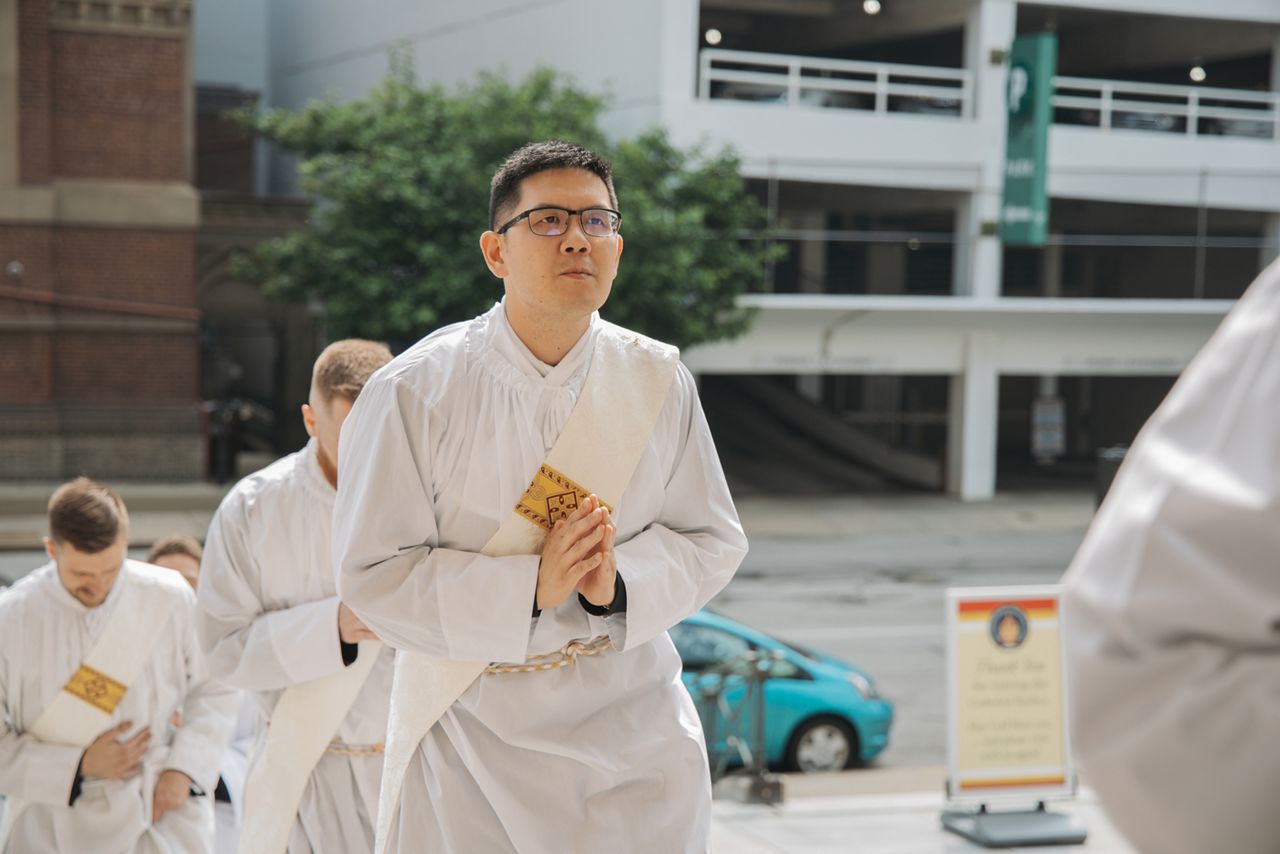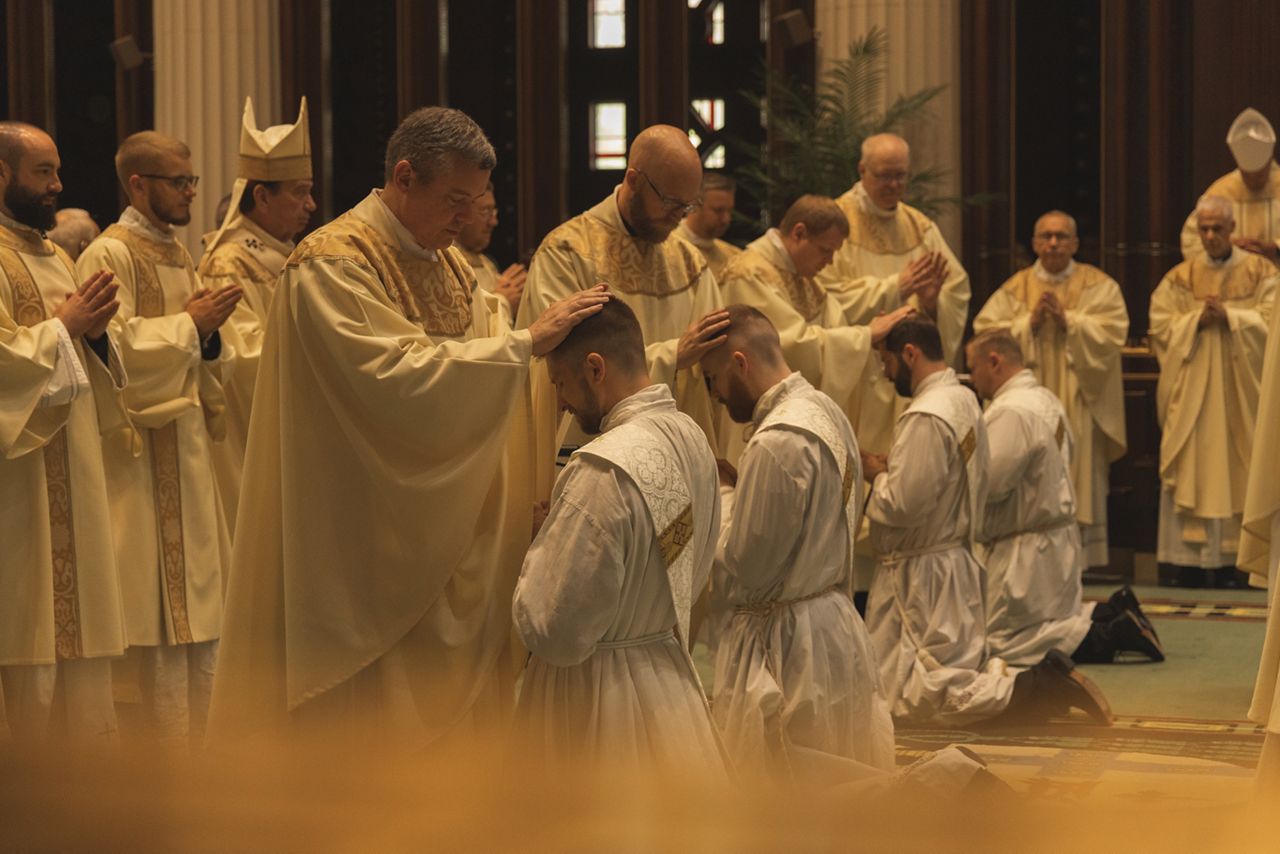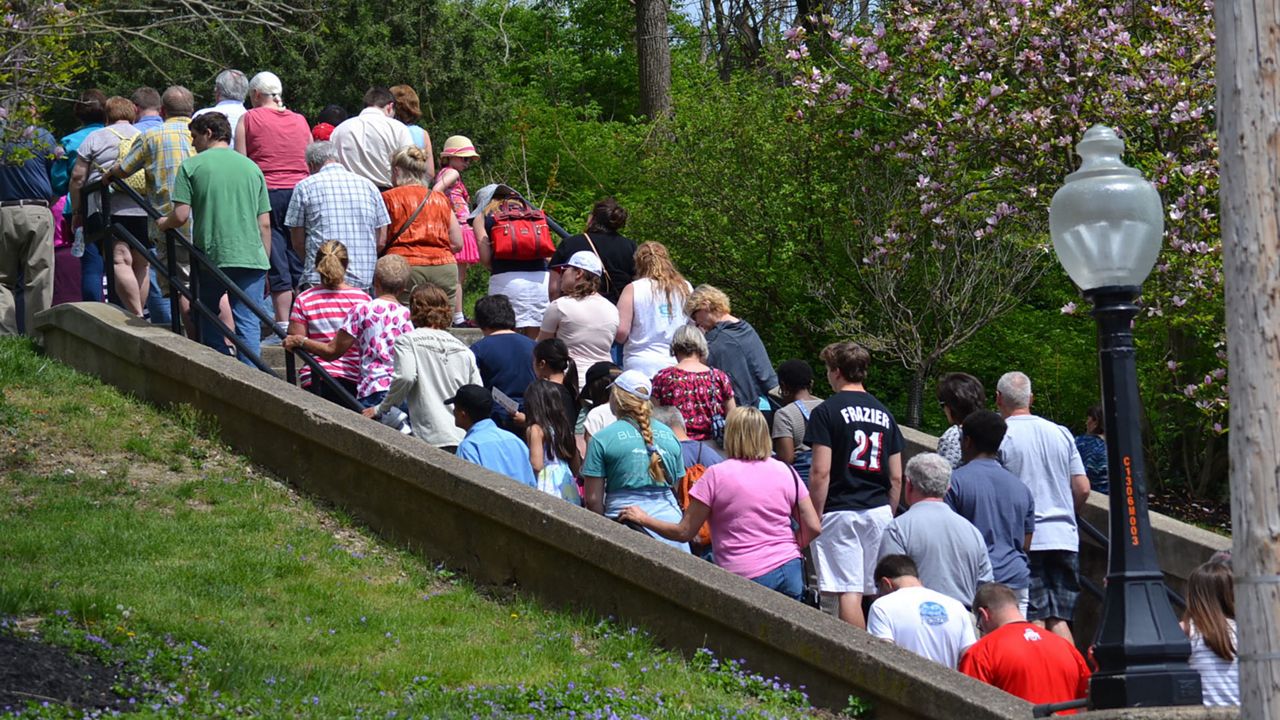CINCINNATI — After decades of dealing with an aging priest population, the Archdiocese of Cincinnati continued a recent youth movement this weekend with the ordination of seven people.
The men — all in their late 20s or early 30s — received the rite of ordination on Saturday in front of a standing-room-only crowd at the Cathedral Basilica of St. Peter in Chains in downtown Cincinnati.
The seven new priests are Patrick Blenman, Isaiah Callan, Alex Dugas, Stephen Hughes, Jonathan Jergens, Jeff Stephens and David Duy Tran.
What You Need To Know
- The Archdiocese of Cincinnati ordained seven new priests on Saturday
- The church is in the middle of a years-long restructuring rooted partially in a lack of available priests
- Most of the new priests will take over a "family of parishes" that consists of a group of nearby churches
- This is the archdiocese's third straight seven-person ordination class
During the ordination rite, Archbishop Dennis Schnurr laid his hands on the men during the two-and-a-half hour Mass. The act symbolizes Jesus giving his apostles the authority to make new priests.

Schnurr congratulated each of the new priests on their journey to get to Saturday. He called the day the culmination of years of careful discernment, fervent prayer, hard work, and “the generous outpouring of God’s grace.”
Dugas expressed excitement but also humility about his long-awaited ordination day.
“I am so excited to serve the faithful of the Archdiocese of Cincinnati,” he said.
Prior to ordination, each man served as a transitional deacon for the last year. In that role, they could baptize people, assist at marriages and preaching at Mass, but they couldn’t conduct all the roles of a priest until Saturday. They gave their first “rites” to their friends and family who’d gathered at the church.
Following Saturday’s service, each of the new priests received their assignment as a parochial vicar.
Tran will serve the parish of St. Ignatius of Loyola in Monfort Heights. Jergens is going to St. Susanna in Mason. The other five new priests will work at clusters of regional churches as part of the archdiocese’s years-long reorganization.
Dugas, for example, is the new parochial vicar at four different churches in Cincinnati’s eastern neighborhoods.
Dale Sullivan made the trip to Cincinnati from Chesapeake, Va., to celebrate Hughes, his childhood best friend. Hughes, 32, will oversee St. Columban and St. Margaret of York, both in Loveland.
“It’s a lot of different emotions that hit you fast,” Sullivan said of watching his friend of more than 20 years become a priest. He recalled all the sleepovers, baseball games and playful trouble they’d get into as kids in Hamilton, Ohio.
Sullivan, a practicing Catholic, knows a fair number of priests, but this is the first he’s ever known as a friend first.
“You grow up knowing priests, but you always saw them as authority figures; people you look up to and respect. But now, I know someone on that other side now.”
“Knowing that Stephen is now Father Stephen is an odd feeling,” he said with a laugh. “But it’s a good feeling. I’m really proud of him.”
Shelby Bravo, 27, attended Saturday’s Mass with her husband, Rafael, and their young daughter, Mireya. They were there to celebrate Blenman, a childhood friend.
Saturday’s ceremony was not too dissimilar from traditional Sunday service in a Catholic church, Shelby said. But it featured a few more “elaborate” elements as well.
Each of the priests in attendance, for example, prayed over all seven newly ordained men. Others helped dress the newly ordained men in their priestly robes.
One thing that stood out, Bravo said, was the size of the audience. Almost every pew space on the church floor was full, as was the balcony. The building has an official capacity of 1,148 people.
She called it “touching” to see the reverence those who gathered had for “these individuals and our church.”
But the packed house isn’t something many of the diocese’s churches have seen in recent years.
A historically Catholic area, the Cincinnati region is now the 51st-largest diocese in the country. Today there are about 435,000 Catholics spread across the archdiocese’s 19-county territory. At its peak, more than 600,000 called the region home.
From 2010 to 2019, local sacramental practice — things like baptisms, first communions and weddings — dropped by roughly 23%, per the archdiocese. That data showed the average Sunday Mass is about one-third full.
A major concern is the decrease in the number of priests.
There are only 141 active priests available for assignment across the 200-plus parishes in the archdiocese.
Before this weekend, the average age of active priests in the archdiocese was 54, with most having been ordained for 21 years on average. Projections from the archdiocese call for the number of priests to decline by 20% over the next five years.
The Bravo family lives in St. Henry, Ohio, about an hour north of Dayton. The community falls inside the archdiocese. The family’s home is close to the historic Maria Stein Shrine of the Holy Relics. Over the years, church services in her parish have been led by older or retired priests who live at the shrine.
“They just don’t have enough ordained staff to cover all parishes,” Shelby Bravo said.
Nic Ranz grew up in the Roman Catholic Church and still considers himself a “believer,” though he admitted he doesn’t attend Mass except for special occasions like Saturday. He was there to celebrate the ordination of his wife’s relative, he said.
There’s “much good stemming from the church and its believers,” Ranz said. But he feels for anyone who wasn’t raised Catholic or religious, the church may seem too “exclusive, intimidating and overwhelming.”
The sexual abuse scandals that rocked the church over the years haven’t helped either, Ranz said. He said the church “hopefully resolved” many of those issues. Still, those issues, he believes, caused people to view the religion and the priesthood in a “more negative light.”
Ranz feels strongly that adding younger priests could make the church “more comfortable and welcoming” for many people.

“Younger generations will listen more if the person they’re talking to is more relatable,” Ranz added.
In 2020, the Archdiocese of Cincinnati began its reconfiguration plan — Beacons of Light — to merge its 208 existing parishes into 57 “families of parishes.”
The plan aims to help the archdiocese address “grossly underutilized” facilities and millions of dollars in deferred maintenance. A major component of Beacons of Light was staffing and sharing resources.
The restructuring process began last July. The archdiocese will release its first annual update this summer.
Shelby’s friend, who grew up in Sidney, Ohio, is taking over as a parochial vicar in the area surrounding Dayton. Blenman’s assignment includes Mary Help of Christians in Fairborn; Sacred Heart in New Carlisle; St. Augustine in Jamestown; St. Brigid in Xenia; St. Luke in Beavercreek; and St. Paul in Yellow Springs.
“The priests who have been assigned to these parishes have been very open and promoting conversation and dialogue about the different changes and what they really mean for our parishes,” she said.
While the number of priests continues to go down, there have been positive signs in recent years. Saturday marked the archdiocese’s third straight year with an ordination class of seven men. It’s their fifth class of that size since 2009. The largest recent class featured nine men in 2019.
This most recent group graduated on May 14 from The Athenaeum of Ohio, Mount St. Mary’s Seminary. The process to become a priest took each man at least seven years.
Sullivan called this new group of priests “exactly what the church needs right now.” He said they’ll bring “youthful energy” and fresh ideas. He described his lifelong buddy as being typically “stoic” but also having the “pizzazz” necessary to relate to younger congregants.
“The church is in good hands right now,” Sullivan said.






